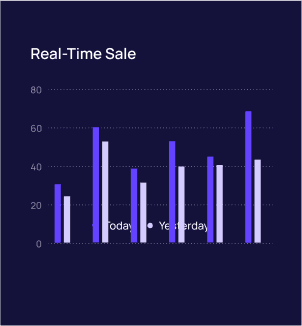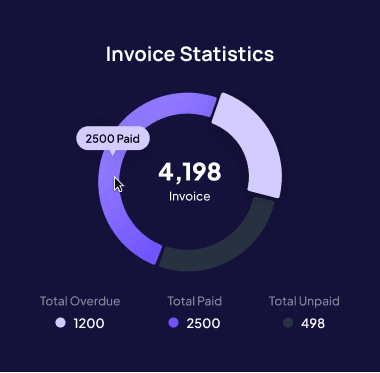Mastering Cash Flow: A Step-by-Step Guide for Entrepreneurs
Mastering Cash Flow: A Step-by-Step Guide for Entrepreneurs
Managing debt wisely ensures that more of your revenue is available for business development.
Managing debt wisely ensures that more of your revenue is available for business development.

Reducing Debt and Interest Costs
Excessive debt and high interest payments can drain cash flow, limiting your ability to invest in growth. A proactive debt reduction strategy helps maintain financial flexibility.
Prioritize high-interest debt repayments to reduce financial strain.
Refinance loans for lower interest rates if better terms become available.
Consolidate debts to simplify payments and potentially lower interest costs.
Avoid over-reliance on credit for daily operations unless absolutely necessary.
Managing debt wisely ensures that more of your revenue is available for business development rather than being consumed by interest payments.
Monitoring and Adjusting Cash Flow Strategies
Even the best cash flow strategies require ongoing monitoring and adjustments. Business environments change, and cash flow plans should adapt accordingly.
Review cash flow statements regularly. Monthly analysis helps identify trends and potential risks.
Adjust pricing strategies. Ensure prices cover costs while remaining competitive.
Analyze customer payment behaviors. If late payments increase, consider stricter credit policies.
Continuously refine expense management. New cost-saving opportunities arise as businesses evolve.
By keeping a close eye on cash flow trends, businesses can make data-driven decisions that promote financial health.

Managing Accounts Receivable Efficiently
Late payments from customers can cause significant cash flow challenges. To keep your cash flow healthy, implement strategies that encourage prompt payments.
Establish clear payment terms: Define due dates, late fees, and interest penalties upfront.
Offer early payment incentives: Providing discounts for early payments can accelerate cash inflows.
Automate invoicing and reminders: Use accounting software to send automatic payment reminders to customers.
Follow up promptly on overdue invoices: Implement a structured collection process to avoid long-standing receivables.
By improving your accounts receivable management, you ensure a steady stream of incoming cash and minimize the risk of cash shortages.
Controlling Accounts Payable
Managing how and when you pay your suppliers can have a significant impact on cash flow. Rather than paying invoices immediately, optimize your accounts payable strategy.
Negotiate extended payment terms: Many suppliers are open to longer payment cycles if you have a strong relationship.
Use just-in-time (JIT) inventory management: This minimizes cash tied up in stock while ensuring you have what you need.
Prioritize essential payments: Rent, payroll, and utilities should take priority over discretionary expenses.
Take advantage of early payment discounts when beneficial: If cash flow allows, paying early can save money in the long run.
By carefully scheduling payments, businesses can maintain liquidity and keep cash available for critical operations.
Optimizing Operating Expenses
Cutting unnecessary costs is a direct way to improve cash flow. Many businesses lose money through inefficient spending without realizing it.
Conduct regular expense audits: Analyze monthly expenses and identify non-essential costs.
Negotiate lower costs with suppliers and vendors: If you’ve been a long-term customer, request better pricing.
Reduce energy and utility costs: Simple changes like energy-efficient lighting and equipment can save money.
Streamline staffing costs: If necessary, use part-time or contract employees to adjust labor costs based on demand.
By keeping expenses lean, your business can operate more efficiently and preserve cash for strategic investments.

Reducing Debt and Interest Costs
Excessive debt and high interest payments can drain cash flow, limiting your ability to invest in growth. A proactive debt reduction strategy helps maintain financial flexibility.
Prioritize high-interest debt repayments to reduce financial strain.
Refinance loans for lower interest rates if better terms become available.
Consolidate debts to simplify payments and potentially lower interest costs.
Avoid over-reliance on credit for daily operations unless absolutely necessary.
Managing debt wisely ensures that more of your revenue is available for business development rather than being consumed by interest payments.
Monitoring and Adjusting Cash Flow Strategies
Even the best cash flow strategies require ongoing monitoring and adjustments. Business environments change, and cash flow plans should adapt accordingly.
Review cash flow statements regularly. Monthly analysis helps identify trends and potential risks.
Adjust pricing strategies. Ensure prices cover costs while remaining competitive.
Analyze customer payment behaviors. If late payments increase, consider stricter credit policies.
Continuously refine expense management. New cost-saving opportunities arise as businesses evolve.
By keeping a close eye on cash flow trends, businesses can make data-driven decisions that promote financial health.

Managing Accounts Receivable Efficiently
Late payments from customers can cause significant cash flow challenges. To keep your cash flow healthy, implement strategies that encourage prompt payments.
Establish clear payment terms: Define due dates, late fees, and interest penalties upfront.
Offer early payment incentives: Providing discounts for early payments can accelerate cash inflows.
Automate invoicing and reminders: Use accounting software to send automatic payment reminders to customers.
Follow up promptly on overdue invoices: Implement a structured collection process to avoid long-standing receivables.
By improving your accounts receivable management, you ensure a steady stream of incoming cash and minimize the risk of cash shortages.
Controlling Accounts Payable
Managing how and when you pay your suppliers can have a significant impact on cash flow. Rather than paying invoices immediately, optimize your accounts payable strategy.
Negotiate extended payment terms: Many suppliers are open to longer payment cycles if you have a strong relationship.
Use just-in-time (JIT) inventory management: This minimizes cash tied up in stock while ensuring you have what you need.
Prioritize essential payments: Rent, payroll, and utilities should take priority over discretionary expenses.
Take advantage of early payment discounts when beneficial: If cash flow allows, paying early can save money in the long run.
By carefully scheduling payments, businesses can maintain liquidity and keep cash available for critical operations.
Optimizing Operating Expenses
Cutting unnecessary costs is a direct way to improve cash flow. Many businesses lose money through inefficient spending without realizing it.
Conduct regular expense audits: Analyze monthly expenses and identify non-essential costs.
Negotiate lower costs with suppliers and vendors: If you’ve been a long-term customer, request better pricing.
Reduce energy and utility costs: Simple changes like energy-efficient lighting and equipment can save money.
Streamline staffing costs: If necessary, use part-time or contract employees to adjust labor costs based on demand.
By keeping expenses lean, your business can operate more efficiently and preserve cash for strategic investments.

Reducing Debt and Interest Costs
Excessive debt and high interest payments can drain cash flow, limiting your ability to invest in growth. A proactive debt reduction strategy helps maintain financial flexibility.
Prioritize high-interest debt repayments to reduce financial strain.
Refinance loans for lower interest rates if better terms become available.
Consolidate debts to simplify payments and potentially lower interest costs.
Avoid over-reliance on credit for daily operations unless absolutely necessary.
Managing debt wisely ensures that more of your revenue is available for business development rather than being consumed by interest payments.
Monitoring and Adjusting Cash Flow Strategies
Even the best cash flow strategies require ongoing monitoring and adjustments. Business environments change, and cash flow plans should adapt accordingly.
Review cash flow statements regularly. Monthly analysis helps identify trends and potential risks.
Adjust pricing strategies. Ensure prices cover costs while remaining competitive.
Analyze customer payment behaviors. If late payments increase, consider stricter credit policies.
Continuously refine expense management. New cost-saving opportunities arise as businesses evolve.
By keeping a close eye on cash flow trends, businesses can make data-driven decisions that promote financial health.

Managing Accounts Receivable Efficiently
Late payments from customers can cause significant cash flow challenges. To keep your cash flow healthy, implement strategies that encourage prompt payments.
Establish clear payment terms: Define due dates, late fees, and interest penalties upfront.
Offer early payment incentives: Providing discounts for early payments can accelerate cash inflows.
Automate invoicing and reminders: Use accounting software to send automatic payment reminders to customers.
Follow up promptly on overdue invoices: Implement a structured collection process to avoid long-standing receivables.
By improving your accounts receivable management, you ensure a steady stream of incoming cash and minimize the risk of cash shortages.
Controlling Accounts Payable
Managing how and when you pay your suppliers can have a significant impact on cash flow. Rather than paying invoices immediately, optimize your accounts payable strategy.
Negotiate extended payment terms: Many suppliers are open to longer payment cycles if you have a strong relationship.
Use just-in-time (JIT) inventory management: This minimizes cash tied up in stock while ensuring you have what you need.
Prioritize essential payments: Rent, payroll, and utilities should take priority over discretionary expenses.
Take advantage of early payment discounts when beneficial: If cash flow allows, paying early can save money in the long run.
By carefully scheduling payments, businesses can maintain liquidity and keep cash available for critical operations.
Optimizing Operating Expenses
Cutting unnecessary costs is a direct way to improve cash flow. Many businesses lose money through inefficient spending without realizing it.
Conduct regular expense audits: Analyze monthly expenses and identify non-essential costs.
Negotiate lower costs with suppliers and vendors: If you’ve been a long-term customer, request better pricing.
Reduce energy and utility costs: Simple changes like energy-efficient lighting and equipment can save money.
Streamline staffing costs: If necessary, use part-time or contract employees to adjust labor costs based on demand.
By keeping expenses lean, your business can operate more efficiently and preserve cash for strategic investments.
Recent Posts
Recent Posts
Recent Posts

Similar Blog You May Like
Similar Blog You May Like
Similar Blog You May Like


Unlock Your Financial Potential with Automation
Create dynamic budgets with predictive insights and scenario planning to help you manage future cash flows.




Unlock Your Financial Potential with Automation
Create dynamic budgets with predictive insights and scenario planning to help you manage future cash flows.




Unlock Your Financial Potential with Automation
Create dynamic budgets with predictive insights and scenario planning to help you manage future cash flows.







